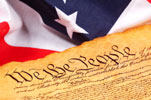 Teacher Guide to the United States Constitution
Teacher Guide to the United States Constitution
The United States Constitution stands as a model of cooperative political movements and a great benefit to the United States of America and her citizens. By skillfully maneuvering through the dangerous and deep waters of arguments and disagreements the politicians and the statesmen that convened at Independence Hall in Philadelphia on May 14, 1787 presented to the entire world what cooperation can lead to. Freedom.
What started out as only two states sending delegates to the state house or otherwise known as Independence Hall in Philadelphia turned into a quorum of seven states on May 25. What the U.S. Constitution did for the United States of America was federally and legally lay down how much power to allow the central government, how many representatives in Congress to allow each state, and how these representatives should be elected--directly by the people or by the state legislators.
The Constitution is presented below in a short abbreviated version so that you can become familiar with the opening paragraph that is so vitally important to the democracy of the United States of America for descriptive purposes. That is what makes up the core of the U.S. Constitution and it can be referred to as a collection of heavily debated and successfully brought to an agreement listing of articles.
Please have a look at this portion of the United States Constitution and then think about the power that is contained within this document that not only grants rights to the citizens of the United States but also ordains responsibilities of freedom.
The Constitution of the United States
We the People of the United States, in Order to form a more perfect Union, establish Justice, insure domestic Tranquility, provide for the common defense, promote the general Welfare, and secure the Blessings of Liberty to ourselves and our Posterity, do ordain and establish this Constitution for the United States of America.
In many ways community helpers remind us of how inter-connected our lives are when we live in a given community. A dentist who helps a teacher with a toothache by extension helps a student have a chance to learn. A cop who maintains the safety of a neighborhood allows a postal worker to do his or her job without fretting about unsavory neighborhoods. If everybody performs their role with an eagerness to help others, life in the community as a whole improves.
Article. I. Section. 1.
All legislative Powers herein granted shall be vested in a Congress of the United States, which shall consist of a Senate and House of Representatives.
Section. 2.
The House of Representatives shall be composed of Members chosen every second Year by the People of the several States, and the Electors in each State shall have the Qualifications requisite for Electors of the most numerous Branch of the State Legislature.
No Person shall be a Representative who shall not have attained to the Age of twenty five Years, and been seven Years a Citizen of the United States, and who shall not, when elected, be an Inhabitant of that State in which he shall be chosen. When vacancies happen in the Representation from any State, the Executive Authority thereof shall issue Writs of Election to fill such Vacancies. The House of Representatives shall choose their Speaker and other Officers; and shall have the sole Power of Impeachment.
Section. 3.
The Senate of the United States shall be composed of two Senators from each State, chosen by the Legislature thereof for six Years; and each Senator shall have one Vote.
Done in Convention by the Unanimous Consent of the States present the Seventeenth Day of September in the Year of our Lord one thousand seven hundred and Eighty seven and of the Independence of the United States of America the Twelfth In witness whereof We have hereunto subscribed our Names,
George Washington President and Deputy from Virginia
Virginia James Madison Jr.
New York Alexander Hamilton
Pennsylvania B Franklin